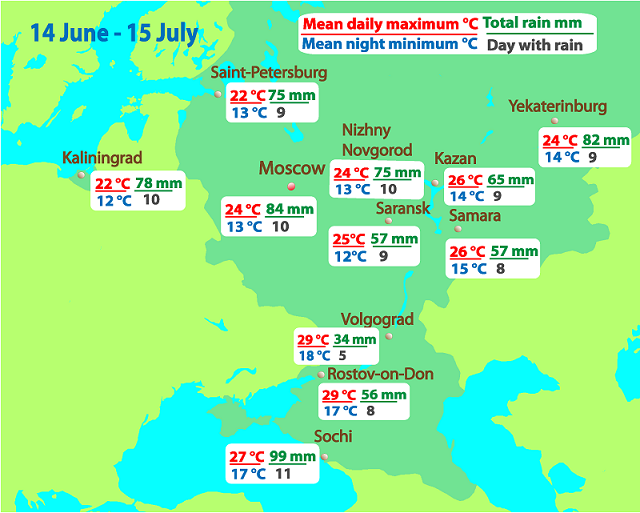The climate in European Russia varies from temperate maritime one in Kaliningrad and St. Petersburg to sharply continental in Volgograd and subtropical in Sochi. In the second half of June-the first half of July (14 June – 15 July) Northern cities: Kaliningrad, St. Petersburg, Moscow, Nizhny Novgorod have more comfortable for the game climate. The average daily maximum temperature there is 22...24 ° C, with not cool nights. For the period from June 14 to July 15, 9-10 days with rain is usual. Yekaterinburg has about the same conditions. It won't be very hard for the players if the games are assigned even in the middle of the day. A little warmer and drier weather can be expected In Kazan, Samara and Saransk. It is even hotter and noticeably drier in Rostov-on-don and Volgograd, where the average daily maximum is 29 ° C. In Volgograd the absolute daily maximum temperature of these days is one of the highest and equal to 40,2 ° C (1954). In these cities it will be more comfortable to play in the evening. The nights there are also warm and cannot bring enough relax from the heat of the day. The average daily maximum for Sochi is 27 ° C, it is also a very warm city, as it should be the resort. Its climate is humid and the average total precipitation (99 mm) is the largest. There in Sochi are not excluded very heavy rains, when the daily total amount of precipitation may exceed the monthly average.
In the cities hosting the 2018 FIFA World Cup, the length of the day and night varies greatly depending on the latitude. The difference between the duration of day and night will be minimal in Sochi, but in St. Petersburg people can enjoy the great time of white nights.
The main feature of our weather is its great variability. The inhabitants of the Northern countries can feel hot in our country, and for those, who came from the subtropics, the weather may seem cool, although many types of weather in our time are familiar to all.
Much will depend on what preferences the audience will have in matches and cities. The problems arising from the changeable weather are solved with the help of clothes. Sunglasses, umbrellas, something like jackets (which may be needed after the evening matches) are desirable to have.
The weather can change quickly. Showers with thunderstorms and squalls can replace hot weather. Cold can come after rain suddenly. It can set more stable weather, but the heat and increase the fire risk will accompany it. Sometimes a prolonged period of cool and rainy weather can be observed.






